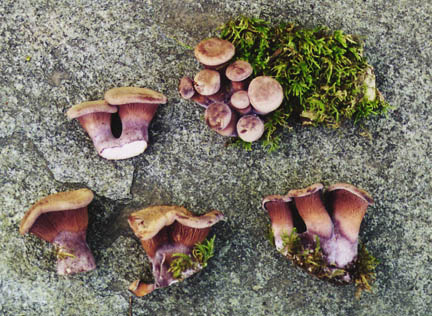
We have a winner for this round! His name is Mihkel Lepson, in Oregon, and he has correctly identified this fungus. I have added the species to the gallery list, and you can find it among those if you look carefully. I won't include the species name here, so you can test yourself if you are interesed. My thanks go out to Mihkel for his observational skills.
I occasionally find a mushroom that I can't identify. To be honest, it happens frequently. Usually, though, the specimen is so generic that I simply don't want to spend the hours it takes narrowing down the dozens of possibilities among thousands of generic small duff-colored gilled fungi. I'm still a beginner at this, after all.
On the other hand, sometimes - very rarely - I find something
interesting and attractive that I still can't identify. Here is
a page for me to put these specimens, in hopes that a sharp-eyed
fungophile might recognize the species, email with an answer and
make me feel stupid. If you happen to be said sharp-eyed fungophile,
feel free to send me your guess by emailing to ![]() (please
manually copy this address into your email, as it is a graphic
to escape the pam crawlers.) If, on the other hand, you happen
to be an expert mycologist and you still can't figure out what
this is, please contact me for a dried sample, and remember to
mention my name when you give your acceptance speech for that
Nobel Prize in mycology.
(please
manually copy this address into your email, as it is a graphic
to escape the pam crawlers.) If, on the other hand, you happen
to be an expert mycologist and you still can't figure out what
this is, please contact me for a dried sample, and remember to
mention my name when you give your acceptance speech for that
Nobel Prize in mycology. 
Description: This mushroom was fruiting in the Springtime, in a redwood grove on the San Francisco peninsula, from the fallen trunk of a Douglas Fir tree, heavily covered with sphagnum moss. It has lilac colored decurrent gills and lilac "skin" or outer flesh, with pure white inner flesh, which exhibits no staining reaction. The gills are not as deep and fully developed as an Agaricale, but they appear more developed than most Cantharellaceae. The cap is slightly more tan colored than the gills, and the entire surface of the mushroom has a velvety covering. Spore print was very slow to form, and appears to be light tan in color. Flesh was firm but not dry or corky, odor mild, mossy and pleasant. Size ranging from 1-5 cm tall, cap ranging from 1-6 cm wide. Edibility untested.
